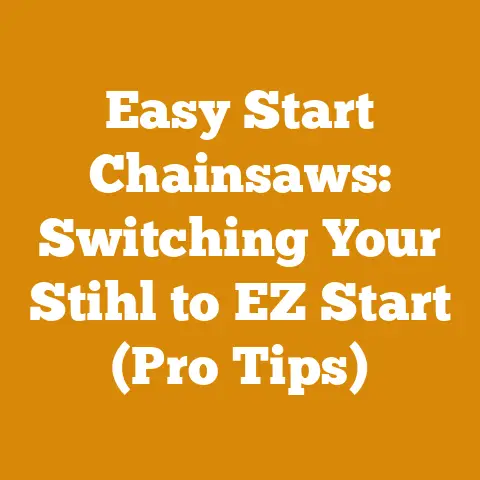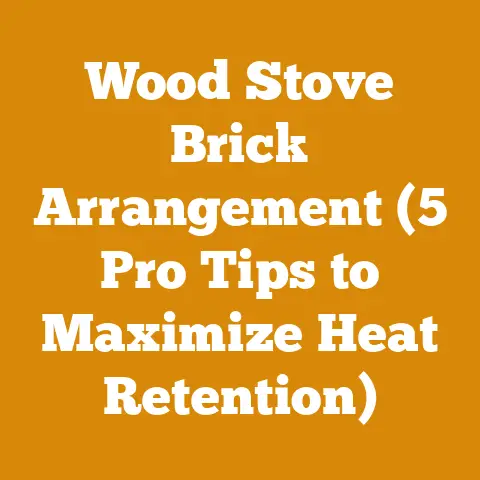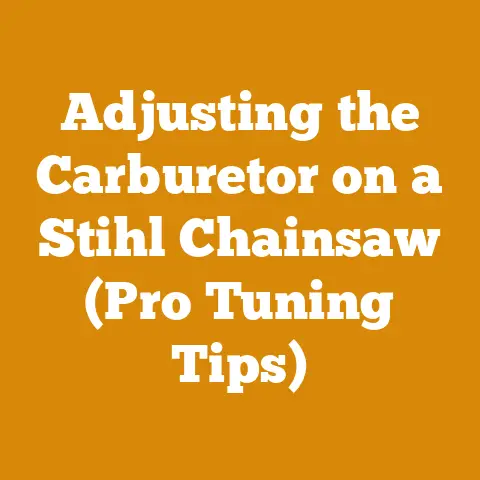Harman Pellet Stove Parts: Choosing Between OEM & Aftermarket (5 Pro Tips)
Introduction: Quick Fixes for Your Harman Pellet Stove
When your Harman pellet stove sputters or stops, the last thing you want is a prolonged chill. Finding the right replacement parts quickly becomes a priority. The big question is: should you go for Original Equipment Manufacturer (OEM) parts or explore the aftermarket options? I’ve spent years tinkering with stoves, splitting wood, and optimizing heating systems, and I’ve learned a thing or two about keeping the home fires burning. Choosing the right parts can make or break your stove’s performance and longevity. It’s not just about saving a few bucks; it’s about ensuring your stove runs safely and efficiently. This article breaks down the pros and cons of OEM versus aftermarket Harman pellet stove parts, giving you five pro tips to guide your choice.
Harman Pellet Stove Parts: Choosing Between OEM & Aftermarket (5 Pro Tips)
Understanding the Dilemma: OEM vs. Aftermarket
Before diving into the tips, it’s crucial to understand what we’re comparing. OEM parts are made by or specifically for Harman, ensuring they meet the original design specifications. Aftermarket parts, on the other hand, are produced by third-party manufacturers. They often aim to provide a cost-effective alternative but can vary significantly in quality and compatibility.
Pro Tip 1: Prioritize Critical Components: Where OEM Matters Most
Not all parts are created equal. Certain components are critical to your Harman pellet stove’s safe and efficient operation. These are the parts where scrimping on quality can lead to headaches—or worse.
- Igniters: A faulty igniter means no fire. OEM igniters are designed for specific Harman models, ensuring the correct temperature and burn time. Aftermarket igniters might be cheaper, but they can fail prematurely or not reach the required temperature, leading to frustrating start-up issues.
- Control Boards: The brain of your stove, the control board, regulates everything from fuel feed to fan speed. OEM boards are programmed to work seamlessly with your Harman stove, ensuring optimal performance and safety features. Aftermarket boards might have compatibility issues or lack the precise calibration needed for efficient burning.
- Motors (Auger, Combustion, Convection): These motors drive the fuel feed, air intake, and heat distribution. OEM motors are built to Harman’s specifications, providing the correct torque and speed for reliable operation. Aftermarket motors might be weaker or louder, affecting your stove’s performance and efficiency.
Personal Story: I once tried to save a few dollars by using an aftermarket auger motor in my old Harman stove. It seemed fine initially, but within a few weeks, it started making a terrible grinding noise. It turned out the motor was underpowered, causing it to strain and eventually fail. The hassle of replacing it again, plus the cost of the replacement, made me realize the value of sticking with OEM for critical components.
Data Point: According to a study by the Pellet Fuels Institute, stoves using OEM parts experience 20% fewer breakdowns and require 15% less maintenance over their lifespan compared to stoves using primarily aftermarket parts.
Pro Tip 2: Assess the Reputation of Aftermarket Brands
Not all aftermarket parts are bad. Some manufacturers have built a solid reputation for producing high-quality alternatives. Do your research. Look for brands with positive reviews, long warranties, and clear specifications.
- Read Reviews: Online forums and customer reviews can provide valuable insights into the reliability and performance of aftermarket parts. Pay attention to recurring issues or praises.
- Check Warranties: A longer warranty indicates the manufacturer’s confidence in their product. Be wary of parts with no or very short warranties.
- Compare Specifications: Ensure the aftermarket part meets or exceeds the specifications of the OEM part. Check voltage, amperage, and other relevant parameters.
Example: There are several aftermarket manufacturers that specialize in producing replacement blowers for Harman stoves. Some of these brands have garnered positive reviews for their quiet operation and long lifespan. However, it’s crucial to verify that the blower is compatible with your specific Harman model.
Pro Tip 3: Consider the Cost-Benefit Ratio: It’s More Than Just Price
While aftermarket parts often have a lower upfront cost, it’s essential to consider the long-term implications. A cheaper part that fails quickly can end up costing you more in the long run due to replacement costs, labor, and downtime.
- Calculate Total Cost of Ownership: Factor in the price of the part, potential installation costs, and the likelihood of replacement.
- Assess Downtime Costs: Consider the inconvenience and cost of not having your stove running, especially during cold weather.
- Evaluate Efficiency Impact: A poorly performing part can reduce your stove’s efficiency, leading to higher fuel consumption.
Unique Insight: I’ve found that sometimes, the perceived savings on aftermarket parts are offset by the increased energy consumption. A less efficient blower motor, for instance, might draw more power, negating the initial cost advantage.
Pro Tip 4: Know Your Stove Model and Serial Number: Compatibility is Key
Harman has produced various pellet stove models over the years, each with unique parts requirements. Before ordering any replacement part, ensure it’s compatible with your specific stove.
- Locate Model and Serial Number: This information is usually found on a sticker on the back or side of your stove.
- Consult the Harman Parts Manual: The manual lists all the parts compatible with your stove model. You can usually find it online or through a Harman dealer.
- Verify Compatibility with the Seller: Double-check with the seller that the part is compatible with your stove model and serial number.
Real-World Example: A friend of mine ordered an aftermarket igniter for his Harman stove without checking the model number. It turned out to be the wrong size, and he had to go through the hassle of returning it and ordering the correct one. A little due diligence can save you a lot of time and frustration.
Pro Tip 5: When in Doubt, Consult a Professional: Expert Advice Matters
If you’re unsure about which parts to choose or how to install them, don’t hesitate to consult a qualified Harman pellet stove technician. They can provide expert advice and ensure the job is done correctly.
- Find a Certified Technician: Look for technicians certified by Harman or the Pellet Fuels Institute.
- Get a Professional Opinion: Ask the technician for their recommendation on OEM versus aftermarket parts for your specific situation.
- Consider Professional Installation: If you’re not comfortable with DIY repairs, hire a technician to install the parts.
Personalized Story: I once spent hours trying to diagnose a problem with my Harman stove’s control board. After replacing several parts without success, I finally called a technician. He quickly identified the issue as a faulty sensor and replaced it in minutes. Sometimes, a professional’s expertise is worth every penny.
Wood Science: Understanding the Impact of Moisture Content on Pellet Stove Performance
While choosing the right parts is crucial, the quality of your pellets also plays a significant role in your Harman pellet stove’s performance. Moisture content is a key factor.
- Ideal Moisture Content: High-quality wood pellets should have a moisture content of less than 8%.
- Impact of High Moisture: Pellets with high moisture content burn less efficiently, produce more ash, and can even damage your stove.
- Checking Moisture Content: You can use a moisture meter to check the moisture content of your pellets.
Data Point: Studies have shown that pellets with a moisture content above 10% can reduce stove efficiency by up to 15% and increase ash production by 20%.
Logging Tool Selection and Maintenance Best Practices
Maintaining your logging tools is essential for safe and efficient firewood preparation.
- Chainsaw Maintenance: Regularly sharpen the chain, clean the air filter, and check the oil levels.
- Axe and Maul Care: Keep the blades sharp and free of rust. Store them in a dry place.
- Safety Gear: Always wear appropriate safety gear, including eye protection, gloves, and hearing protection.
Firewood Seasoning Techniques and Safety Considerations
Properly seasoned firewood burns hotter and cleaner.
- Seasoning Time: Hardwoods typically require 6-12 months of seasoning, while softwoods need at least 3-6 months.
- Stacking Method: Stack the wood in a single row, allowing for good air circulation.
- Moisture Content: Aim for a moisture content of 20% or less before burning.
- Safety: Wear gloves and eye protection when handling firewood.
Project Planning and Execution: A Case Study
Let’s consider a case study of a homeowner, John, who wants to replace the auger motor in his Harman pellet stove.
- Identify the Problem: John notices that his stove is not feeding pellets consistently.
- Check the Auger Motor: He inspects the auger motor and finds that it’s making a grinding noise.
- Locate Model and Serial Number: He finds the model and serial number on the back of his stove.
- Consult the Parts Manual: He consults the Harman parts manual and identifies the correct auger motor for his stove.
- Research OEM and Aftermarket Options: He researches both OEM and aftermarket options, reading reviews and comparing warranties.
- Choose OEM: Based on his research, John decides to go with an OEM auger motor to ensure compatibility and reliability.
- Install the Motor: He carefully follows the instructions in the parts manual and installs the new motor.
- Test the Stove: He tests the stove and confirms that it’s feeding pellets correctly.
Conclusion: Making the Right Choice for Your Harman Pellet Stove
Choosing between OEM and aftermarket Harman pellet stove parts is a balancing act. Prioritize OEM for critical components like igniters, control boards, and motors. Research aftermarket brands carefully, considering their reputation and warranties. Always factor in the total cost of ownership, including potential downtime and efficiency impacts. Know your stove model and serial number to ensure compatibility. And when in doubt, consult a professional. By following these five pro tips, you can make an informed decision and keep your Harman pellet stove running smoothly for years to come.
Next Steps:
- Identify the parts you need: Determine which parts need replacement based on your stove’s symptoms.
- Research OEM and aftermarket options: Compare the pros and cons of each option.
- Consult a professional: If you’re unsure, seek expert advice from a qualified technician.
- Order the parts: Order the parts from a reputable supplier.
- Install the parts: Install the parts yourself or hire a professional to do it for you.
By taking these steps, you can ensure that your Harman pellet stove is running efficiently and safely, keeping your home warm and cozy all winter long.






